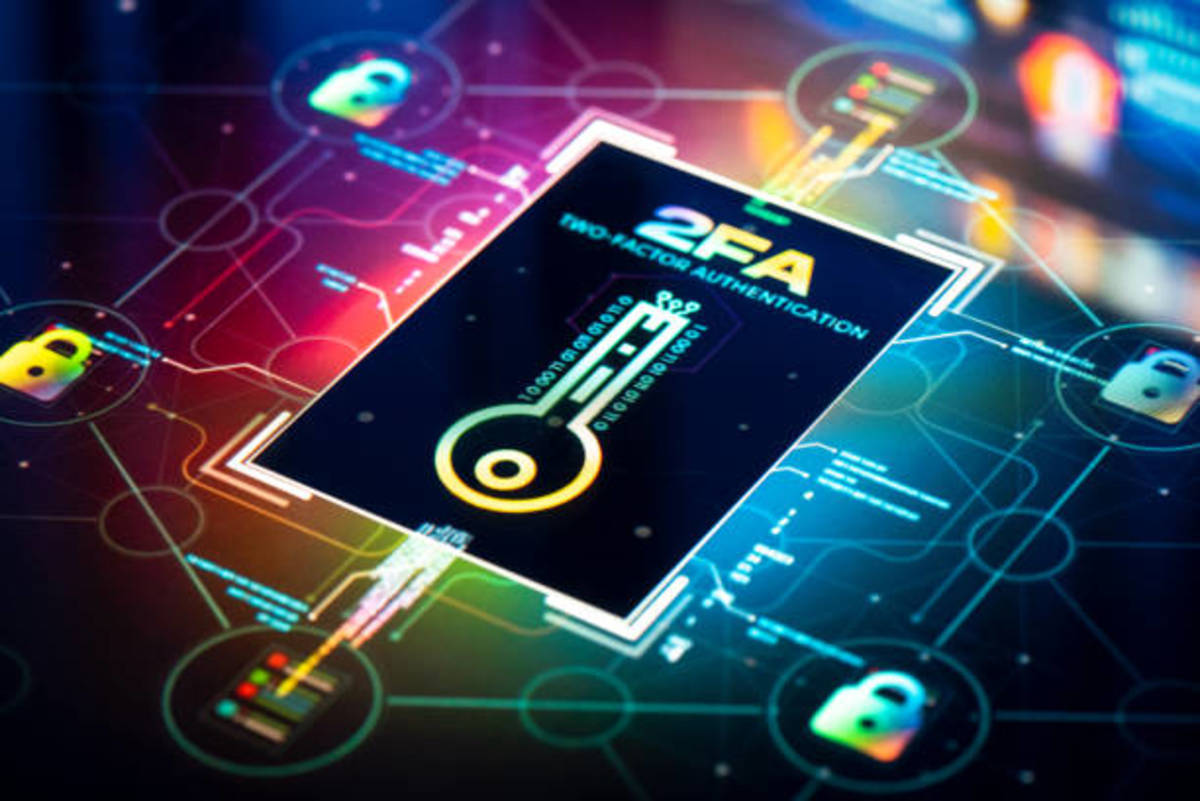Two-factor authentication, also known as 2fa, is a security mechanism that needs two different forms of identification to gain access to something. Continue reading to learn how to enable 2fa to avoid being hacked.
Two-factor authentication, also known as 2fa, is a security mechanism that needs two different forms of identification to gain access to something. Two-factor authentication can be used to make an online account, a smartphone, or even a door more secure. Before anything that is being secured may be accessed, the two-factor authentication requires two forms of information from the user, a password or personal identification number (PIN), a code given to the user’s smartphone, or a fingerprint.
Understanding the two-factor authentication
What is two-factor authentication?
Two-factor authentication which is also known as 2fa is a type of authentication that verifies anything you have in addition to the one-factor authentication. There will be a requirement in this sort of authentication where you must present what you know about the server before being authenticated.
There are many different sorts of two-factor authentication products in the market right now. PKI USB token, OTP token, and smart card are a few of the most popular. These devices will give an additional piece of information needed to complete the authentication.
Why is two-factor authentication needed?
Two-factor authentication helps in improving safety. With only one-factor authentication, an attacker who knows your login and password can always log in until you reset your password. It can also aid in the prevention of password brute force attacks.
Two-factor authentication has long been a common and well-known requirement in the financial business, particularly when conducting a banking transaction. Although it can be difficult at times, consumers are willing to put up with the inconvenience due to the lack of security provided by having only one authentication method.
How does two-factor authentication work?
Well, even though there are many different types of two-factor authentication products on the market, they all work in the same way such that the user must supply his or her username, password, and the second factor for any authentication.
The second component in two-factor authentication one-time password is the random number generated by the device. The PKI USB token, on the other hand, is plugged in and used to perform a digital signature on the transaction before sending it to the server for verification. If the second factor is not provided, any critical authentication should fall.
The conclusion is that two-factor authentication is the second factor of authentication that verifies what you have. There is also three-factor authentication, which verifies who you are using the following technology sequence.
The first factor is what you already know. The second factor is what you already have. The third factor is who or what you are. A fingerprint or facial scan is an example of three-factor authentication. The third factor, on the other hand, is both inconvenient and expensive to apply. As a result, two-factor authentication is the finest IT security solution to date, balancing simplicity and security.
Two-factor authentication enhances your security process
Major corporations in a variety of industries, including healthcare, banking, and education, are upgrading their data storage and record management systems to allow for remote access to information via a network or the internet.
Although many of these systems have security, many of the security mechanisms used, such as static usernames and passwords, are insufficient to guard against undesirable, man-in-the-middle attacks, malware, and other sorts of fraud assaults.
For many users, static usernames and passwords are easy to hack, forget, and lose. For a long time, username and password combinations have been considered a standard for online authorization, and many users feel comfortable with this sort of protection.
Many sectors have set standards to demand stricter security procedures for remote access to sensitive data. Stronger security measures must be established across industries to preserve the privacy and integrity of information as access to this sensitive data grows and becomes more widespread.
Stronger authentication methods, such as two-factor authentication, have become the standard of authorization in several industries, including healthcare and finance, to counteract the rising number of fraud assaults.
Two-factor authentication, such as utilizing a login and a one-time password through a mobile device, is a considerably more secure technique of verifying a user who is authorized to access data remotely. Unauthorized users attempting to access sensitive data will be thwarted because, even if they have one element of authentication, they will not be able to access the sensitive data without the second factor of authentication.
With the rise of fraud, malware, and online fraud, static usernames and passwords are no longer sufficient to safeguard against attacks and can be easily hacked. Even if you update your login credentials frequently, using static passwords does not guarantee that fraudulent attacks will be stopped, and access to critical information may still be compromised. Using two-factor authentication dramatically minimizes the risk of fraud and improves the security of your authentication process for authorized users.
Because a dynamic password can be supplied from a different channel than the primary channel requesting the password, strong two-factor authentication solutions that use one-time passwords and leverage out-of-band networks provide an even higher level of security.
An authorized user, for example, is viewing their online banking statement and uses a login, which they know, and a one-time password, which is sent to their mobile phone over a separate channel (mobile network) and is also the second element of authentication, which they have (mobile phone).
Because the password validating the user is sent from a separate network, two-factor authentication using an out-of-band authentication method improves the security process by reducing the risk of assaults such as man in the middle attacks, malware, and phishing attacks.
Using numerous networks to verify an authorized user makes fraud attacks more difficult and reduces the risk of data being intercepted. Two-factor authentication, like any other security solution, is not foolproof against fraud, but it is one of the most effective ways to authenticate users and protect critical data. Adding layers of security, such as two-factor authentication, is and will continue to be the standard in many businesses to defend against fraud and unauthorized access.
Because most users already have access to a mobile device such as a phone to authenticate themselves, two-factor authentication solutions that use out-of-band authentication with one-time passwords can be easily implemented and cost-effective in many organizations.
There are no expensive hardware tokens to deploy, and most users already have access to a mobile device such as a phone to authenticate themselves. Without considerable user training, two-factor authentication can be simply applied in a variety of security procedures, including network servers, the cloud, computer hardware, and software.
One method fraud assaults happen is through threats to internet security such as hardware and software keyloggers. These types of threats are often difficult to detect, and two-factor authentication solutions that use out-of-band authentication with dynamic one time passwords reduce these types of attacks because keyloggers will be unable to retrieve the second factor of authentication, such as the dynamic one-time password sent through a mobile phone, even if they can retrieve the first factor of authentication.
Stronger security measures must be adopted to prevent attacks and authenticate authorized users as more institutions provide remote access to critical information. Many industry rules and regulators, such as HIPAA and the federal financial institutions’ examination council, have already made two-factor authentication a norm to assist protect against escalating fraud assaults.
To protect sensitive data and boost consumer confidence in data privacy, businesses across industries must develop tighter security measures. The standard in authentication is two-factor authentication with one-time passwords and can improve the security operations of many enterprises for years to come.
3 reasons your business can not ignore two-factor authentication
In recent years, login security breaches have become all too common. Fraud assaults, stolen passwords, and software that records all of our keystrokes are all things we hear about. Once upon a time, data breaches would have prompted a demand to use stronger, more difficult passwords, but research has revealed that two-thirds of all data breaches are the result of weak or stolen passwords. The once-in-a-lifetime password has become the weakest link in the chain.
This is where two-factor authentication, also known as 2fa, comes into play. By simply adding a second element of authentication to the normal username and password, two-factor authentication is a simple yet incredibly powerful technique of boosting security via the user login sequence.
One needs to have a fundamental understanding of authentication to truly appreciate the value of two-factor authentication. Authentication, or the process of confirming your identity, is made up of three basic components:
- Something the user is aware of like a pin or password.
- Something that belongs to the user like a mobile phone or a device.
- Something that the user is interested in like biometric retina, fingerprints, etc.
The problem with using something you already know like a password is that it may be shared, guessed, or hacked, and while a username and password may appear to be two factors, they are actually both something you already know.
Two-factor authentication, on the other hand, combines two of these unique identities, and frequently includes information about something the user owns and something the user knows. Because fingerprint or retina recognition software is expensive and complex to develop, biometric information is less commonly used.
The logon sequence with two-factor authentication involves not only a password but also a passcode that is sent directly to the user’s device. Incorporating these two distinct identities in the user login procedure, despite its simplicity, provides a level of protection and security for the user that even the most sophisticated password can no longer provide. Two-factor authentication’s beauty is that it provides a smooth and cost-effective solution by just leveraging what the user already owns.
Benefits
It is more difficult to compromise your data
Two-factor authentication offers an additional degree of security to your accounts while also acting as a deterrent. Although an attacker may be able to breach one layer of your authentication, compromising both is extremely tough. With only one layer of authentication to login credentials, an attacker is significantly more likely to move on to an easier target.
The consequences of a data breach are less severe
Even if you are the victim of a data breach, you will have much less to worry about with two-factor authentication. Even if passwords or other personal data have been revealed in a breach, your identity and data should be safe if you use something you have or something you are as additional levels in your authentication process.
Any efforts to get access to your account are reported to you
Two-factor authentication also has the benefit of alerting you to unauthorized attempts to access your account, such as receiving a text message with a passcode while you are not using it. By using two-factor authentication, you will be alerted to any unauthorized logins immediately, allowing you to take additional security precautions such as changing your password or other account security settings.
Does your organization’s website need two-factor authentication?
Regardless of your organization’s demands, there are numerous sorts of two-factor authentication solutions. While these systems differ slightly, they all have one thing in common that is certificate-based network authentication. This is due to the fact that it is typically easy to deploy, user-friendly, and applicable to desktop computers, mobile devices, and cloud-based services.
Users or devices who are permitted to access a server, website, or cloud are identified via digital certificates. When this is combined with the first phase of authentication, which requires the user to log in, your business will be able to see who accessed what information, when they accessed it, and from which device they accessed it. The following are the many methods of certificate-based two-factor authentication:
Certificates for the server and the machine
Server and machine certificates are used to control which servers or other machines have access to your company’s servers and PCs. This certificate-based authentication adds another degree of security by guaranteeing that only machines with pre-approved authorizations may access corporate information, similar to how you require your employees to check-in using a password to gain access to company email or secure company websites.
USB tokens and smart cards
A security certificate is stored on a tangible item, such as a smart card or USB token, in this type of two-factor authentication. This adds an extra degree of protection by guaranteeing that only individuals having physical access to these objects have access to your company’s secure network. The only thing the end-user needs to remember is to carry their smart card or enter the USB token. They are also simple to transfer, making this a low-cost two-factor authentication solution.
Cloud computing services
Two-factor authentication on cloud services necessitates the deployment of a digital certificate that restricts which users have access to cloud-stored data. Because many existing cloud services are already compatible with two-factor authentication, deployment is quite straightforward. Google Apps, SalesForce, SharePoint, and Amazon web services, for example, are all cloud-based software packages that support two-factor authentication using digital certificates.
WiFi networks, VPNs, and Gateways
The certificates required to safeguard entire networks must be exceedingly strong while also allowing access to persons who are not physically present in the building where the servers are located. It is necessary to secure all devices within an organization, but there is also a problem for outside staff who may need access to corporate resources while on the road, or for a client who may want restricted access to business documents. A VPN or gateway that is secured with a digital certificate can tell who the user is and what device they are using to access it.
If you are unsure which type of two-factor authentication is best for your company, speak with a digital certificate supplier about your specific requirements. Your business can use two-factor authentication methods to keep your organization and your customer’s personal information safe with little to no setup.
Benefits of two-factor authentication
Two-factor authentication, sometimes known as tokenless two-factor authentication, is a security approach that employs two steps or forms of verification before allowing access to guarded data. Its goal is identical to that of single-factor authentication, with one major exception.
There is no need to supply anything other than a login and password when using single-factor authentication. A username and password, as well as other information, will be required for two-factor authentication. This is done in order to beef up security and better secure data.
Authentication entails entering a username and password, as well as additional information for identity verification. The person may be requested to provide a pass mark at this point, usually to confirm that a user-associated image is being displayed.
A pass mark might sometimes be a question asked by the user when he first created his login details. A classic example of this is when an email user loses his password and wishes to make a new one. Before the email provider can allow a password reset, the user must first answer a security question that he created when he created his account.
Offline applications and two-factor authentication
It is also used in a variety of offline apps. Entering a secured facility by supplying a number code, then undergoing a biometric test to authenticate the person’s identification, is a popular example. Sensors for fingerprint scanning are commonly used in this form of verification. The person may be let into the premises if the previously entered passcode, the scanned fingerprint, and the fingerprint saved in the database match. Facial scans, optic scans, and speech recognition may be used in addition to fingerprint scanning.
As the number of people transacting business online grows, so do the risks. When sending money through an online merchant, for example, the security of both the sender’s and receiver’s accounts may be jeopardized. Payments made online with credit cards may raise security issues for its owners.
Hackers can easily obtain bank account or credit card information if no solid security measures are used when utilizing them. Identity theft is often associated with hacking, and it can have major ramifications for the victim. Even offline, increased criminality rates have made tokenless two-factor authentication systems for secured places all the more vital.
Is one’s information safe without two-factor authentication?
Hundreds of firms have boosted their security by using two-factor authentication. With this technology, you can ensure that your client’s information is safe against hackers, fraud, and identity theft, as well as the important information of your entire company.
When should two-factor authentication be used?
Because the two-factor system requires you and your staff to input two forms of identity before computer data can be accessed, it can benefit practically any firm. This procedure safeguards your organization and ensures that it continues to run properly. Everyone must have experienced the devastation that an abrupt interruption in the flow of work can cause.
Who is at risk from threats?
Any corporate or government database that does not use two-factor authentication is vulnerable. Here are a few of the people who are most at risk.
- Computers are used in medical facilities to store and access patient information and records.
- Companies that hire visitors or temporary workers.
- Companies have travel-related staff, such as consultants and salespeople.
- Businesses in which employees work in close quarters or share a computer.
- Employers hire people to work from home in areas that require access to the business database.
- Companies that provide online banking services.
- Universities and educational institutions.
What type of safety can be provided by two-factor authentication?
Two-factor authentication was created for more reasons than merely protecting your customers. It can give you an additional layer of security within your company‘s security infrastructure. This is critical since every firm has sensitive data to safeguard. Here are some examples of sensitive data that two-factor authentication can help protect.
- Lists of clients
- Information about the health of patients
- Personal contact details for employees
- Other information about employees, such as social security numbers and pay
- Sensitive research findings
- Records of criminal activity
- Information about the client, such as contact information and financials
- Information about your credit card
- Files for students
Should one use two-factor authorization?
What is two-factor authentication and when did it begin? When you are forced to use two forms of identification to get into a website or open an email, this is known as two-factor authentication. It began as a result of people employing weak or non-existent passwords.
A password is usually the first factor. One should remember to use numbers, big and small letters, and symbols in your passwords. They should not be dictionary words and should be at least twelve characters long, with the longest being preferable. A password should never be reused. You will need a password manager to remember them all if you use them correctly. Getting one is well worth the money.
The second factor might range from fingerprint or facial recognition to a website sending you a numeric code via text or email that you must submit as part of the login procedure. Google, Microsoft, and others are developing new methods of authentication that are both secure and user-friendly.
The form of security that people will employ is the finest. Two-factor authentication adds 15-30 seconds to the time it takes to log into a website. That time would be better spent safeguarding your safety. Banks, financial institutions, and healthcare organizations all want to make sure that when a user logs in, it is the correct person. With only a password, this is extremely tough to accomplish. Consider how many passwords were stolen by hackers last year.
Your phone will be used to verify your identification at this point. Assume you visit your bank’s website. If you log in using your phone, your fingerprint or facial recognition can be used to verify your identity. If you’re using a desktop computer, they’ll normally provide you with a numeric code to enter during the login procedure.
In each scenario, you provided the bank with your mobile phone number, giving them some assurance that it is indeed you. You must also enter a password that is the same as the one on file with the bank. Two types of identification are used in Two-Factor Authentication.
Conclusion
Because there are two layers of protection, using two-factor authentication with a login and a one-time password given to a mobile device is effective. The login and password would be the first layer, and the one-time password would be delivered to the mobile device to authenticate the user. Even if an unauthorized user had access to a user’s login and password, they would be unable to recover the password given to the mobile device.












